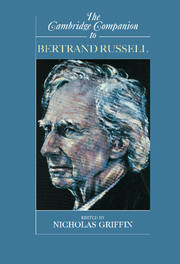Book contents
- Frontmatter
- Introduction
- 1 Mathematics in and behind Russell’s Logicism, and Its Reception
- 2 Russell’s Philosophical Background
- 3 Russell and Moore, 1898-1905
- 4 Russell and Frege
- 5 Bertrand Russell’s Logicism
- 6 The Theory of Descriptions
- 7 Russell’s Substitutional Theory
- 8 The Theory of Types
- 9 Russell’s Method of Analysis
- 10 Russell’s Neutral Monism
- 11 The Metaphysics of Logical Atomism
- 12 Russell’s Structuralism and the Absolute Description of the World
- 13 From Knowledge by Acquaintance to Knowledge by Causation
- 14 Russell, Experience, and the Roots of Science
- 15 Bertrand Russell
- Selective Bibliography
- Index
- Series list
11 - The Metaphysics of Logical Atomism
Published online by Cambridge University Press: 28 May 2006
- Frontmatter
- Introduction
- 1 Mathematics in and behind Russell’s Logicism, and Its Reception
- 2 Russell’s Philosophical Background
- 3 Russell and Moore, 1898-1905
- 4 Russell and Frege
- 5 Bertrand Russell’s Logicism
- 6 The Theory of Descriptions
- 7 Russell’s Substitutional Theory
- 8 The Theory of Types
- 9 Russell’s Method of Analysis
- 10 Russell’s Neutral Monism
- 11 The Metaphysics of Logical Atomism
- 12 Russell’s Structuralism and the Absolute Description of the World
- 13 From Knowledge by Acquaintance to Knowledge by Causation
- 14 Russell, Experience, and the Roots of Science
- 15 Bertrand Russell
- Selective Bibliography
- Index
- Series list
Summary
Bertrand Russell made use of logic as an analytical tool from the start of his philosophical career and early on adopted a metaphysics that can be called “atomism ” in opposition to “monism”. The name “logical atomism” is nevertheless useful for identifying a distinctive combination of metaphysical and logical doctrines characteristic of Russell's work from around 1910 to at least 1925. Russell introduced the name in his series of lectures in 1918 (PLA), so characterising his “philosophical position” and used it again later for the title of a 1924 essay (LA). He describes this philosophy as the combination of a “. . . logical doctrine which seems to me to result from the philosophy of mathematics . . .” and “. . . on the basis of this a certain kind of metaphysic” (PLA, 160). The metaphysics is not simply derivative from his logical theory resulting merely from reading a metaphysical theory off the expressions of a logically perspicuous language. In a passage of the lectures on the notion of complexity Russell describes certain definitions as “. . . preliminary because they start from the complexity of the proposition, which we define psychologically, and proceed to the complexity of the fact, whereas it is quite clear that in an orderly, proper procedure it is the complexity of the fact that you would start from” (PLA, 175). The right way to analyze certain expressions into a logical language would seem to follow from a correct metaphysical analysis of facts rather than leading it.
- Type
- Chapter
- Information
- The Cambridge Companion to Bertrand Russell , pp. 371 - 391Publisher: Cambridge University PressPrint publication year: 2003
- 4
- Cited by



